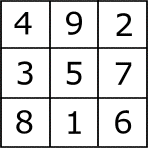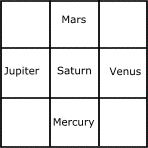
The Luo Shu is actually composed of nine groups of small circles arranged in a square but, by substituting numerals for the groups of circles, we promptly arrive at the following:

This is familiar to many Westerners as a sort of mathematical puzzle known as a Magic Square: here, the numbers in every row and column amount to 15. With the Luo Shu, the Chinese are acredited with the first known magic square in the history of mathematics.
There are actually eight different versions of this square, all with the same sum=15 properties, yet the Luo Shu square is identical with the Magical Square of Saturn, a device used in the Western Magical Tradition to denote the powers of the planet/deity Saturn. This coincidence been the Oriental and Mediterranean cultures is all the more remarkable because the Chinese traditionally associate the planet Saturn with the central square - literally at the heart of the Luo Shu.

There is more information on the Chinese fascination with a design consisting of a core surrounded by eight features, on the page about Jing and the mandala.
The puzzle of why this particular version was so favoured for Feng Shui etc is explored in depth in a series of pages commencing at Luo Shu Origins, which illustrates all eight versions.
But what do we know about the source of the Magical Square of Saturn? Is a single source for both systems more than an intriguing possibility?
Marsilio Ficino (1433 - 1499) lived in Florence and wrote numerous important books on ancient philosophy and cosmology, and is noted for his classifying nature's objects and forces into a system of influences linked to astrology. In 1498 he wrote De Viribus in which he links magic squares with the planets, and specifically links the 3 x 3 magic square with Saturn. An earlier Arabic manuscript, Qabs al-Anwar, by Nadruni was published before 1384 and made the same link. These ideas were popularised by Henry Cornelius Agrippa (1486 - c.1535) in De Occulta Philosophia.
The first European to write about magic squares is usually reckoned to have been Manuel Moschopoulos, in 1300. He was a Greek Byzantine scholar who drew upon works by Arab authorities who had been studying magic squares, and their supposed mystical properties, for several centuries at least. It is generally supposed that the Arabs initially derived mathematical information about such squares from India, rather than China.
However, there is much confusion regarding the early history of magic squares, and one author has claimed that Neo-Platonists in the 3rd century CE knew the 3 x 3 magic square. So a direct link between the Luo Shu and the Magic Square of Saturn cannot be completely ruled out.
I am endebted to a stimulating webpage On The History of Magic Squares by Mark Swaney, which provided an invaluable springboard for my researches. Another particularly useful page is Chronology of Recreational Mathematics by David Singmaster.
© Ken Taylor 2002 - 2006